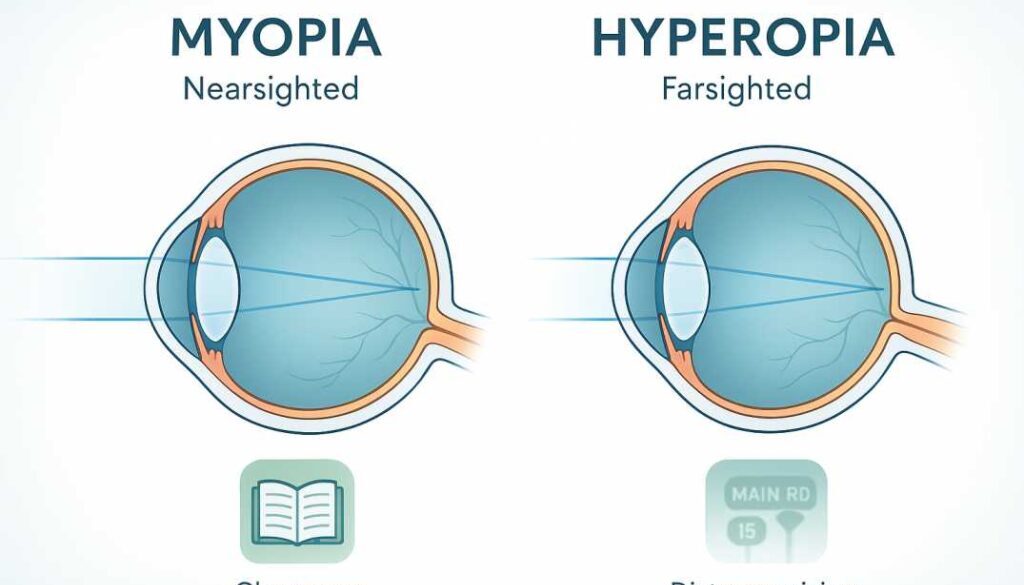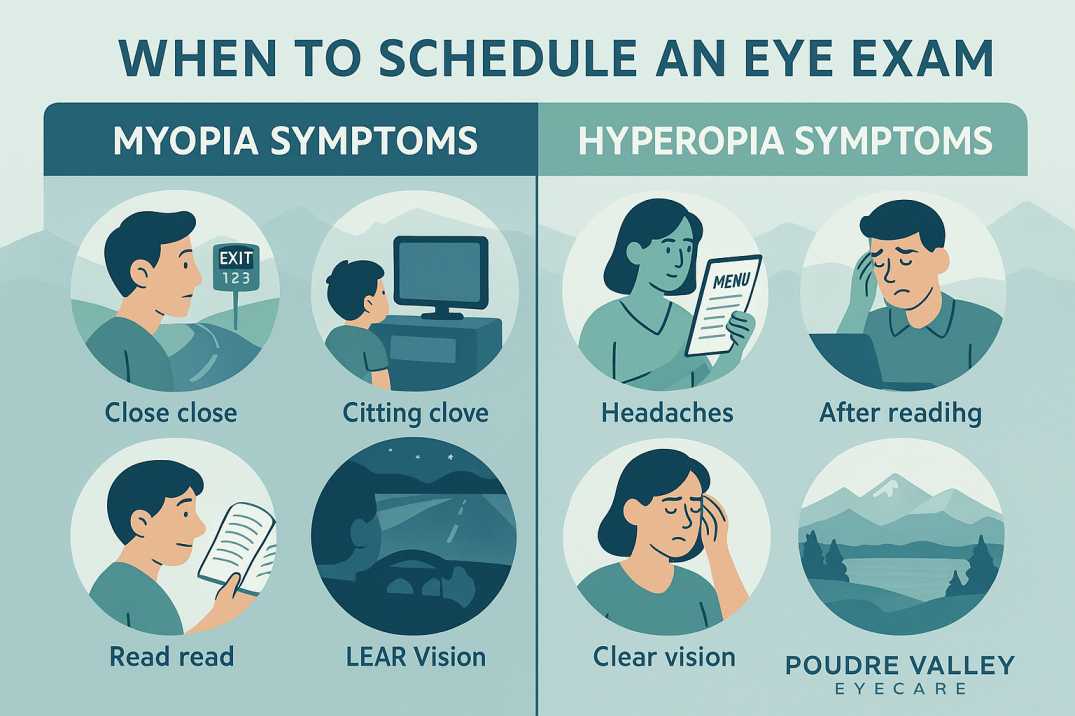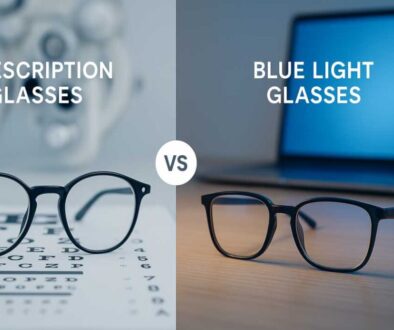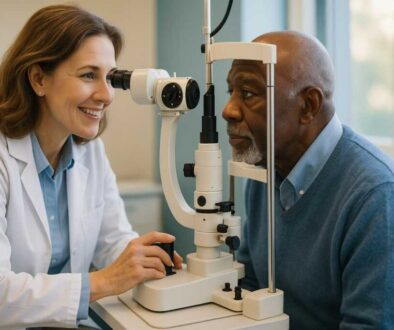Myopia vs Hyperopia: Key Differences & Treatment Guide
Bottom Line Up Front: Myopia (nearsightedness) makes distant objects blurry while close objects remain clear, affecting 42% of Americans as of 2025. Hyperopia (farsightedness) causes blurry near vision but clear distance vision, impacting approximately 8-10% of the US population. Both conditions stem from how your eye focuses light on the retina and can be effectively corrected with glasses, contacts, or surgery. Understanding these differences helps you recognize symptoms early and seek appropriate treatment to protect your long-term eye health.
If you’ve ever squinted at a highway sign while driving or held a menu at arm’s length to read it clearly, you’ve experienced firsthand how refractive errors can impact daily life. At Poudre Valley Eyecare, we’ve helped Fort Collins families understand and manage vision conditions like myopia and hyperopia for over 25 years. Let’s explore what makes these conditions different, why early detection matters, and how modern treatments can restore crystal-clear vision for patients of all ages.
Understanding How Your Eyes Focus Light
Before diving into the differences between myopia and hyperopia, it helps to understand how normal vision works. Your eyes are sophisticated optical instruments designed to focus light precisely on the retina—the light-sensitive tissue at the back of your eye that converts light into the signals your brain interprets as vision.
In a healthy eye, the cornea and lens work together to bend incoming light rays so they converge directly on the retina. The retina then converts this focused light into electrical signals that travel through the optic nerve to your brain, creating the images you see.
The Perfect Focus Formula:
- The cornea provides about 65-70% of your eye’s focusing power
- Lens adjusts its shape to fine-tune focus for different distances
- Light rays converge precisely on the retina
- The brain interprets signals as clear, sharp images
When this delicate focusing system is disrupted by variations in eye shape or lens curvature, refractive errors like myopia and hyperopia occur.
What Is Myopia (Nearsightedness)?
Myopia, commonly known as nearsightedness, occurs when your eyeball is too long or your cornea is too curved, causing light rays to focus in front of the retina instead of directly on it. This refractive error creates the characteristic pattern of clear near vision but blurry distance vision that affects millions of Americans.
Key Characteristics of Myopia:
Visual Symptoms:
- Clear vision for nearby objects (books, phones, computer screens)
- Blurry or fuzzy distant objects (road signs, TV screens, faces across the room)
- Squinting to see distant objects more clearly
- Eye strain when trying to focus on faraway items
Physical Causes:
- Elongated eyeball (most common cause)
- Excessively curved cornea
- Lens with too much focusing power
- Light focuses in front of the retina
The Growing Myopia Epidemic
Myopia rates have reached critical levels globally, with recent 2025 studies confirming that approximately one-third of children worldwide are now affected by myopia. The World Health Organization projects that 3.4 billion people will be myopic by 2030, with nearly 50% of the global population—close to 5 billion people—affected by 2050.
Current Global Statistics:
- United States: 42% of the population is now myopic (up from 25% in the 1970s)
- East Asia: 80-90% of teenagers in countries like South Korea and Singapore
- Children Worldwide: One in three children now has myopia, triple the rate from 1990
- Economic Impact: Over $200 billion in global productivity losses annually
Myopia Risk Factors
Genetic Factors:
- A family history of myopia significantly increases the risk
- Children with one myopic parent have 3x higher risk
- Both parents’ myopia increases the risk to 6x normal
Environmental Triggers:
- Excessive near work (reading, studying, device use)
- Limited outdoor time during childhood
- Urban living environments
- High academic pressure and educational demands
What Is Hyperopia (Farsightedness)?
Hyperopia, commonly called farsightedness, represents the opposite focusing problem from myopia. When your eyeball is too short or your cornea is too flat, light rays focus behind the retina rather than on it. This refractive error typically results in blurry near vision while distance vision remains clear, though severe cases can affect vision at all distances.
Key Characteristics of Hyperopia:
Visual Symptoms:
- Clear vision for distant objects (landscape views, driving)
- Blurry or strained vision for close-up tasks (reading, crafts, phone use)
- Eye fatigue after prolonged near work
- Headaches, especially after reading or computer work
Physical Causes:
- Shortened eyeball (primary cause)
- Flattened cornea curvature
- Weak ciliary muscles
- Light focuses behind the retina
Hyperopia Demographics and Prevalence
Hyperopia affects approximately 8-10% of Americans, with variations by age and geographic region. Recent 2025 data show that about 75 million Americans show signs of hyperopia, though 14 million remain untreated due to access or coverage issues.
Age-Related Patterns:
- Children: Most babies are born with mild hyperopia (8.4% at age 6, decreasing to 1% by age 15)
- Adults 20-39: 9.9% prevalence rate
- Adults 40-59: 12.7% prevalence rate
- Adults 60+: 14.9% prevalence rate
- Regional Variations: Northern states show higher rates (30-40% in adults over 40)
Severity Classifications:
- Mild Hyperopia: +0.25 to +3.00 diopters
- Moderate Hyperopia: +3.00 to +6.00 diopters
- High Hyperopia: Above +6.00 diopters
Myopia vs. Hyperopia: Side-by-Side Comparison
| Aspect | Myopia (Nearsightedness) | Hyperopia (Farsightedness) |
|---|---|---|
| Vision Pattern | Clear near, blurry far | Clear far, blurry near |
| Light Focus | In front of the retina | Behind retina |
| Eye Shape | Too long | Too short |
| Prevalence | 42% of Americans | 8-10% of Americans |
| Age of Onset | Childhood (6-14 years) | Present at birth, noticed later |
| Progression | Worsens until the early 20s | May improve in childhood |
| Prescription | Negative numbers (-3.00) | Positive numbers (+2.50) |
| Long-term Risks | High myopia complications | Generally fewer complications |
Recognizing Symptoms: When to Seek Professional Care
Myopia Warning Signs:
In Children:
- Sitting close to TV or computer screens
- Holding books very close to the face
- Squinting frequently, especially outdoors
- Complaints about seeing the blackboard at school
- Frequent eye rubbing or blinking
- Poor performance in distance-vision activities
Learn more about recognizing vision problems in children with our guide on 5 common eye issues in children.
In Adults:
- Difficulty reading road signs while driving
- Squinting to see movie screens or presentations
- Eye strain during outdoor activities
- Frequent prescription changes
Hyperopia Warning Signs:
- Avoiding close-up activities like reading or puzzles
- Rubbing eyes frequently
- Fatigue after homework or reading
- Poor concentration during near tasks
- Crossed eyes (esotropia)
- Lazy eye development
For comprehensive guidance on children’s vision health, read our article on why your kids need an eye health exam.
In Adults:
- Holding reading material at arm’s length
- Headaches after computer work or reading
- Eye strain during detailed tasks
- Fatigue after prolonged near work
- Difficulty focusing when switching between distances
Can You Have Both Myopia and Hyperopia?
A common question we hear at Poudre Valley Eyecare is whether someone can have both conditions simultaneously. While it’s impossible to have both myopia and hyperopia in the same eye—since they’re opposite refractive defects—it is possible (though rare) to have myopia in one eye and hyperopia in the other.
More Common Combination: Both myopia and hyperopia can occur alongside astigmatism, which causes blurred vision at all distances due to irregular corneal curvature. Learn more about the differences in our detailed comparison of astigmatism vs myopia.
Comprehensive Treatment Options for Myopia and Hyperopia
Non-Surgical Corrections
Prescription Eyeglasses:
- The most common and safest correction method
- Myopia requires negative-powered lenses (concave)
- Hyperopia needs positive-powered lenses (convex)
- Progressive lenses are available for multiple corrections
- Specialized coatings reduce glare and eye strain
Explore our comprehensive guide to different types of glasses lenses and coatings to find the best option for your needs.
Contact Lenses:
- Provide a wider field of vision than glasses
- Available for both conditions in various materials
- Multifocal options for presbyopia combination
- Specialized designs for myopia control in children
Learn about our comfortable contact lens brands and contact lens safety tips for optimal care.
Myopia Control Strategies for Children
Recent advances in myopia management offer hope for slowing progression in children:
- Low-dose atropine eye drops show 30-60% efficacy in slowing progression
- Orthokeratology (overnight contact lenses) that reshape the cornea while sleeping
- Multifocal contact lenses are designed to reduce eye strain during near work
- Specialized spectacle lens designs with peripheral defocus technology
Discover more about the benefits of myopia management for kids and how early intervention can protect your child’s future vision.
Surgical Solutions
LASIK Surgery:
- FDA-approved for myopia up to -12.00 diopters and hyperopia up to +6.00 diopters
- Current 2025 pricing: $1,950-$2,700 per eye at most centers
- Reshapes the cornea using precise laser technology
- Typically performed after age 25 when vision stabilizes
- 95% of patients achieve driving-standard vision or better
Alternative Procedures:
- PRK: Better for thin corneas or high prescriptions
- SMILE: A Newer technique for myopia correction
- Refractive Lens Exchange (RLE): Lens replacement for high prescriptions
- Implantable Contact Lenses (ICL): Reversible option for severe cases
The Science Behind Recent Research Breakthroughs in Vision Correction
Groundbreaking 2024-2025 Studies
Myopia Prevention Research: The 2024 International Myopia Conference revealed promising advances in myopia interventions, including genetic research identifying new treatment targets and innovative light therapy approaches. Researchers are exploring:
- 7-Methylxanthine (7-MX) as an alternative to atropine
- Repeated low-level red light therapy
- Violet light exposure benefits
- Scleral cross-linking for high myopia
Digital Eye Strain Studies: Recent systematic reviews in 2025 are examining the relationship between digital screen time and myopia development, providing clearer guidelines for screen use recommendations.
Genetic Insights: ARVO 2024 research identified genetic variations linked to refractive error in Chinese children, potentially paving the way for personalized treatment approaches.
Long-Term Health Implications
Myopia-Related Complications
High myopia (above -6.00 diopters) significantly increases risks for:
- Retinal Detachment: 10-fold increased risk
- Myopic Macular Degeneration: Leading cause of blindness in some regions
- Glaucoma: 2-3 times higher risk
- Cataracts: Earlier onset and progression
Studies show that every 1 diopter increase in myopia increases myopic macular degeneration risk by 67% and retinal detachment risk by 30%.
Hyperopia-Related Concerns
While generally less severe, hyperopia can lead to:
- Amblyopia (lazy eye) in children
- Accommodative esotropia (crossed eyes)
- Chronic eye strain and fatigue
- Academic or work performance impacts
Prevention Strategies for Families: Protecting Your Vision Health
Protecting Children’s Vision
Outdoor Time Benefits:
- Research suggests that 2 hours of daylight exposure daily may prevent myopia development
- Natural light supports healthy eye growth
- Encourages distance vision use
- Reduces near-work demands
Screen Time Management:
- Follow the 20-20-20 rule: Every 20 minutes, look at something 20 feet away for 20 seconds
- Maintain proper viewing distances
- Ensure adequate lighting during device use
- Encourage breaks from intensive near work
For families concerned about technology’s impact on vision, read our helpful guide on eye health tips for Fort Collins parents with tech-savvy kids.
Regular Eye Examinations:
- Annual exams for children, especially those with a family history
- Early detection enables intervention
- Monitor prescription changes over time
- Assess overall eye health development
Understanding when to schedule these important checkups? Read our guide on how often you should get an eye exam and learn about back-to-school eye exams for children.
Lifestyle Modifications for Adults
Workplace Ergonomics:
- Position computer screens 20-26 inches away
- Top of screen at or below eye level
- Use anti-reflective coatings on lenses
- Adjust lighting to reduce glare
Healthy Vision Habits:
- Maintain proper reading posture
- Use adequate lighting for close work
- Take regular breaks from focused tasks
- Stay hydrated to support tear production
When to See Your Eye Care Professional
Urgent Signs Requiring Immediate Attention:
- Sudden vision changes
- Severe headaches with vision problems
- Flashing lights or floating spots
- Partial vision loss
- Eye pain or discomfort
Regular Checkup Schedule:
Children:
- First eye exam by age 1
- Annual exams throughout the school years
- More frequent monitoring if myopia is detected
Adults:
- Every 2 years, under the age of 40
- Annual exams after age 40
- More frequent visits with existing conditions
Cost Considerations and Insurance Coverage
Treatment Investment Overview:
Non-Surgical Options:
- Glasses: $200-$800+ depending on features
- Contact lenses: $200-$700 annually
- Specialty myopia control lenses: Premium pricing
Surgical Procedures:
- LASIK: $2,000-$4,000 per eye
- PRK: $1,500-$3,500 per eye
- ICL: $4,000-$6,000 per eye
- RLE: $3,000-$5,000 per eye
Insurance Considerations: Most insurance plans cover basic vision correction, but may not include:
- Premium lens options
- Myopia control treatments
- Elective surgical procedures
- Specialized contact lenses
For detailed information about vision insurance coverage in Colorado, check our guides on Medicare vision coverage and Medicaid eye exam coverage.
Technology and Innovation in Vision Correction
Emerging Treatment Technologies
Artificial Intelligence Applications:
- Predictive modeling for myopia progression
- Enhanced surgical planning accuracy
- Automated prescription optimization
Advanced Lens Designs:
- Smart contact lenses with health monitoring
- Liquid crystal adjustable glasses
- Multifocal implants with extended depth of focus
Digital Health Integration:
- Smartphone apps for vision monitoring
- Telehealth consultations
- Remote prescription adjustments
Living Well with Refractive Errors
Daily Life Adaptations
Home Environment:
- Optimize lighting throughout living spaces
- Create dedicated reading areas with proper illumination
- Consider smart home technology for vision assistance
- Maintain clear pathways and organization
Work Productivity:
- Invest in quality computer glasses
- Adjust workstation ergonomics regularly
- Use a document to reduce neck strain
- Consider task-specific glasses for different activities
Recreation and Sports:
- Sports-specific eyewear for active pursuits
- UV protection for outdoor activities
- Water sports considerations for contact lens wearers
- Safety glasses for workshop activities
Resources and Citations
1. Global Myopia Research & Statistics
World Economic Forum – “Short-sightedness is on the rise among kids. Here’s what can be done.”
https://www.weforum.org/stories/2024/10/children-shortsightedness-myopia-screens-indoors/
Source for current WHO projections, childhood myopia statistics, and global economic impact data.
2. Latest Myopia Treatment Research
Myopia Profile – “Latest Myopia Science from IMC: Key Insights for 2025 and Beyond”
https://www.myopiaprofile.com/articles/IMC-Latest-Myopia-Science-Key-Insights-for-2025
Source for 2024 International Myopia Conference findings, treatment efficacy rates, and emerging therapies.
3. Current LASIK Pricing & Treatment Options
Vision Center – “LASIK Eye Surgery Cost Calculator (2025)”
https://www.visioncenter.org/lasik-cost/
Source for 2025 LASIK pricing data, comprehensive cost analysis, and surgical treatment comparisons.
Your Path Forward: Making Informed Decisions
Understanding the differences between myopia and hyperopia empowers you to make informed decisions about your eye health. Whether you’re noticing changes in your vision, concerned about your child’s development, or exploring treatment options, the key is partnering with experienced eye care professionals who can guide you through the available solutions.
At Poudre Valley Eyecare, we believe every patient deserves personalized care that fits their lifestyle and vision goals. Our comprehensive approach combines the latest technology with the warmth and trust that comes from serving the Fort Collins community for more than two decades.
Key Takeaways for Action:
- Recognize the Signs: Early detection of myopia and hyperopia leads to better outcomes
- Seek Professional Care: Regular eye exams are essential for maintaining optimal vision
- Explore Treatment Options: Modern corrections offer more choices than ever before
- Consider Prevention: Lifestyle modifications can help protect against progression
- Stay Informed: Ongoing research continues to improve treatment effectiveness
Ready to take the next step toward a clearer vision? At Poudre Valley Eyecare, we combine 25+ years of experience serving Fort Collins families with the latest technology to provide comprehensive, compassionate care for every member of your family. Whether you need a routine eye exam, are considering myopia control for your child, or want to explore surgical options, our team is committed to helping you achieve the clearest vision possible. We accept Medicare and Medicaid, making quality eye care accessible to everyone in our Fort Collins community.
Contact us today to schedule your comprehensive eye examination and discover how we can help protect and enhance your vision for years to come.
FAQs
-
Myopia (nearsightedness) causes blurry vision when looking at distant objects, while hyperopia (farsightedness) causes difficulty seeing close objects clearly.
Please note: None of the above should be considered medical advice. If you’re having any concerns about your vision, please reach out to us immediately or see your primary care provider.





